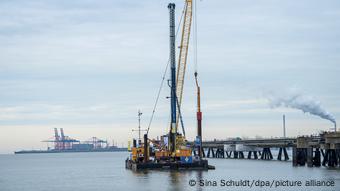
As Russian social media relishes the topic “How Germans will freeze next winter without Russian gas”, Germany itself continues to fill up gas storage facilities ahead of schedule and builds infrastructure to receive liquefied gas, and a group of scientists presented an updated version of the report, in which in March it stated: under certain conditions, in the winter months of 2022/2023, it could run out of supplies from Gazprom.
The filling level of German gas storage facilities reaches 72%
The fill level of underground gas deposits (UGS) has become one of the main macroeconomic indicators in Germany this year, and the Federal Network Agency (Bundesnetzagentur, BNetzA) now publishes a detailed summary with figures and graphs daily.
The point is that German UGS facilities – the most powerful in the entire European Union – can be pumped for about a quarter of the gas that Germany consumes throughout the year. Therefore, its maximum filling is considered the most important prerequisite for the uninterrupted supply of homes and industries during the heating season. In winter, on especially cold days, up to 60% of blue fuel consumption in Germany is provided by reserves in gas storage facilities.
Gazprom has left the biggest UGS facility in Germany and EU Rehden empty, today it is already half full
The latest BNetzA update, dated August 8, states that as of August 6, the average fill rate for German UGSFs was 71.99%. This, it is further claimed, is more and partially significantly higher than it was on the same day in 2015, 2017, 2018 and 2021.
It should be borne in mind that we are talking about the average. Three quarters of German UGSFs are already more than 80% full, BNetzA head Klaus Müller said in early August. He emphasized that only a few gas storage facilities that were previously in Gazprom’s hands, mainly Rehden, cause concern, he emphasized. This is the largest UGS facility in Germany and across the EU before it passed to German state control in early April, it was nearly empty. Now it already contains 48.96% of gas, according to a summary of the agency in the networks. It invariably dedicates a separate line to that more troublesome gas storage.
The German Ministry of Economy has reinforced the filling standards of the UGS facilities
If already in the first days of August the average filling level of the German UGSFs was increased to 72%, it seems very realistic to reach the figure of 75% by the 1st of September. This new intermediate target is set out in a decree from the German Economy Ministry of 28 July, in which it reinforced the requirements of a law adopted in the spring, according to which German gas storage facilities must be filled annually by 1 October. by 80%, by November 1st by 90% and by April 1st by 40%.

The German Economy Ministry became the headquarters for supplying natural gas to Germany this year
Now the defaults at the start of the heating season have been raised to 85% and 95% respectively. An additional approximately 1 billion cubic meters of gas will be needed by November 1 to reach the new target, the ministry explained. By its order, it effectively prohibits energy companies from withdrawing gas from underground storage facilities until this date, even if their supplies to Germany are reduced.
It is significant that the filling of German gas storage facilities continues, and ahead of schedule, in a situation where Nord Stream 1, the main pipeline to supply Germany with Russian gas, after a planned ten-day stoppage in July, is operating at only 20% of its capacity (supposedly due to the fact that a Siemens Energy turbine repaired in Canada has not yet arrived in Russia).
Gas pipeline to the LNG terminal in Wilhelmshaven
The BNetzA summary chart shows that deliveries from Norway have increased since June and imports from the Netherlands and Belgium are stable. LNG terminals in these two countries regasify liquefied gas purchased by German energy companies on the world market, and Germany also receives blue fuel from Dutch gas fields.
However, the capacities of the two LNG terminals in operation in the Netherlands and Belgium are not enough to compensate Germany for the reduction in supplies from Russia – let alone their complete cessation at any time. Thus, five floating LNG leased terminals in Germany are expected to start operating, and three of them – before the end of this year.

Pile placement to expand the berth of the floating LNG terminal in Wilhelmshaven began on May 5
Here the latest news is that near Wilhelmshaven, in the port of which they started to equip a pier for a regasification vessel in early May, on August 4th they started laying pipes. They will connect this LNG terminal to the large Etzel UGSF and several major gas pipelines.
All the necessary permits for this construction were received about a month ahead of schedule, which was greatly facilitated by a special law adopted in the spring to facilitate and accelerate the construction of infrastructure for receiving liquefied gas. The installation of a gas pipeline of approximately 26 kilometers by the end of the year appears to be a fully solvable task. Therefore, Germany’s first LNG terminal in Wilhelmshaven has every chance of being put into operation in December 2022 and thus helping to reduce Germany’s dependence on Russian gas this winter.
Scientists believe: if you save more, you can do without Russia
In fact, Germany could now completely dispense with supplies from Russia – it is only necessary from August 2022 to April 2023 to significantly reduce the consumption of this type of fuel, namely by an additional 25% or 210 terawatt hours (TWh). This is the key thesis of a study presented by a team of authors led by German economist Rüdiger Bachmann, who teaches in the United States at the University of Notre Dame. This study was detailed Aug. 5 by the economic journal Handelsblatt.
Rüdiger Bachmann, along with ten other German economists, in March, shortly after the start of large-scale Russian aggression against Ukraine, investigated the question of whether Germany could impose a gas embargo against Russia as a sanctions measure within the Ukraine. HUH. Even so, the scientists’ conclusion, which made a lot of noise, said: it could. Now, the authors have updated their March report from a new angle and have again arrived at a similar result: Germany is able to withstand a complete shutdown of Russian gas supplies.

Mehrum became the first coal-fired reserve power plant in Germany in early August
For this, however, it is necessary to reduce electricity production in gas-fired plants by around 60 TWh, temporarily increasing production, mainly in coal-fired plants, by another 60 TWh to reduce gas consumption by households, which would have to reduce the usual winter room temperature by about 2.5 degrees and save 90 TWh in the industry.
The report and the various gas-saving measures proposed in it caused a mixed reaction in expert circles, writes Handelsblatt. But in any case, the work of the team of authors led by Rüdiger Bachmann shows that the scientific community continues an intense search for solutions that can end Germany’s gas dependence on Russia as quickly as possible.
Evonik can replace up to 40% of the gas consumed
Meanwhile, the German chemical company Evonik announced on August 8 that it could reduce the use of gas, mainly needed to generate electricity and steam, by around 40% at its facilities in Germany, without affecting production processes. In the near future, the company intends to use petroleum and coal products more widely. Evonik reports that it consumes approximately 5 TWh of natural gas per year in Germany. So, just for this industrial consumer, the gas savings can reach 2 TWh.
Source: DW
James Springer is a renowned author and opinion writer, known for his bold and thought-provoking articles on a wide range of topics. He currently works as a writer at 247 news reel, where he uses his unique voice and sharp wit to offer fresh perspectives on current events. His articles are widely read and shared and has earned him a reputation as a talented and insightful writer.